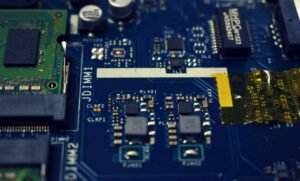Neural Networks for Binary Classification
Neural networks are a fundamental concept in machine learning and have gained significant attention in recent years, due to their ability to solve complex problems and achieve high accuracy. One popular application of neural networks is binary classification, where the task is to classify data into one of two classes.
Key Takeaways:
- Neural networks are powerful models used in binary classification.
- They can learn complex patterns and make accurate predictions.
- Training a neural network requires labeled data and iterative optimization.
- Regularization techniques help prevent overfitting in neural networks.
- Choosing the right architecture and hyperparameters is crucial for achieving optimal performance.
In binary classification, a neural network takes an input and predicts the probability of the input belonging to one of the two classes. The network consists of multiple layers of interconnected neurons, each performing a weighted sum of inputs and passing the result through an activation function. *This process allows the network to learn intricate relationships between the input features and the target classes.*
Benefits of Neural Networks for Binary Classification
- Neural networks can capture complex patterns in the data that might not be easily discernible by traditional algorithms.
- They have high flexibility and can adapt to different types of data, including images, text, and numerical data.
- Once trained, neural networks can make fast predictions on new, unseen data.
- The ability to handle large datasets makes neural networks suitable for big data applications.
During training, the neural network adjusts its weights and biases using an optimization algorithm to minimize a loss function. This process involves forward propagation to compute predictions and backward propagation to update the network’s parameters based on the prediction errors. *By iteratively refining the weights, the network gradually improves its ability to classify the data accurately.*
Regularization Techniques
Regularization techniques are important in neural networks to prevent overfitting, where the model performs well on the training data but poorly on unseen data. These techniques add a penalty term to the loss function, discouraging the network from relying too heavily on certain features or overfitting the training examples. *For example, L1 and L2 regularization impose constraints on the magnitude of the weights and biases, promoting sparsity and preventing over-parameterization.*
Choosing the Right Architecture and Hyperparameters
- The number of layers and the number of neurons in each layer are key design choices in neural network architecture.
- Deep neural networks with multiple hidden layers can learn hierarchical representations of the data.
- Hyperparameters, such as learning rate, batch size, and activation functions, greatly influence the network’s performance.
- Cross-validation and grid search techniques can help find the optimal values for hyperparameters.
| Activation Function | Advantages | Disadvantages |
|---|---|---|
| Sigmoid | Smooth output, good for binary classification problems | Prone to vanishing gradients, outputs close to 0 or 1 may saturate |
| ReLU | Avoids vanishing gradients, computationally efficient | May suffer from “dying ReLU” problem if neurons are not properly initialized |
Neural networks excel in binary classification tasks by leveraging their ability to learn complex patterns. By training on labeled data and iteratively optimizing their parameters, neural networks can achieve high accuracy in predicting the class labels of new data instances. *Their flexible nature, ability to handle large datasets, and regularization techniques make them a powerful tool for binary classification tasks in machine learning.*
| Regularization Technique | Advantages | Disadvantages |
|---|---|---|
| L1 Regularization | Promotes sparsity, helps with feature selection | May result in underfitting if regularization strength is too high |
| L2 Regularization | Controls weights’ magnitudes, improves generalization | Regularization strength needs to be carefully tuned |
In conclusion, neural networks are powerful tools for binary classification tasks, offering the ability to learn complex patterns and achieve accurate predictions. Their application requires attention to model architecture and hyperparameter tuning, as well as the use of regularization techniques to prevent overfitting. With proper design and optimization, neural networks can provide valuable insights and predictions for a wide range of binary classification problems.

Common Misconceptions
Misconception 1: Neural networks are only useful for complex tasks
Many people believe that neural networks are only beneficial for solving complex problems and should not be used for simple binary classification tasks. However, this is not true as neural networks can efficiently analyze and classify data in a binary manner, even for simple problems.
- Neural networks can effectively classify binary data with high accuracy.
- Even simple binary classification tasks can benefit from neural networks’ ability to learn complex patterns.
- Neural networks can adapt and improve their performance over time, making them suitable for all types of classification tasks.
Misconception 2: Neural networks always require huge amounts of data
Another common misconception is that neural networks always demand massive amounts of training data to perform well. While having more data can enhance the performance of a neural network, it is not always a strict requirement.
- Neural networks can generalize well and provide accurate binary classifications even with limited training data.
- With proper regularization techniques and data preprocessing, neural networks can achieve satisfactory results with a small dataset.
- The performance of a neural network can often be improved by using transfer learning and pre-trained models, which leverages knowledge from larger datasets.
Misconception 3: Neural networks are always black boxes and lack interpretability
There is a common perception that neural networks are black boxes, making it difficult to understand how they arrive at their predictions. While neural networks can be complex, there are ways to interpret their results and gain insights into their decision-making process.
- Approaches like gradient-based methods and saliency maps can help identify important features and understand the neural network’s decision-making process.
- Neural networks can be designed with a specific architecture that promotes interpretability, such as using attention mechanisms.
- By visualizing the learned representations within the neural network, it is possible to gain insights into the features that influence the binary classification.
Misconception 4: Neural networks are always computationally expensive
Some people believe that neural networks are always computationally expensive and require high-end hardware to train and deploy. While it is true that neural networks can be computationally demanding, there are ways to scale down the complexity or leverage available resources efficiently.
- Techniques like quantization and model compression can reduce the computational cost of neural networks without significantly sacrificing accuracy.
- Using hardware accelerators, such as GPUs or TPUs, can speed up the training and inference processes, making neural networks more accessible.
- Neural network frameworks offer optimizations and parallelization techniques to distribute the workload across multiple devices or servers.
Misconception 5: Neural networks always require fine-tuning and manual parameter adjustments
There is a misconception that neural networks always require extensive fine-tuning and manual parameter adjustments to achieve good performance. While hyperparameter tuning can improve the results, neural networks are also capable of learning and adjusting their parameters automatically.
- Advanced optimization algorithms, such as stochastic gradient descent, can automatically find the optimal set of parameters for neural networks.
- Modern frameworks often provide automatic hyperparameter search options, reducing the need for manual adjustment.
- Transfer learning allows leveraging pre-trained models and their tuned parameters, significantly reducing the need for manual parameter adjustments.

Neural Networks for Binary Classification
Neural networks have emerged as powerful tools for binary classification, enabling machines to make decisions by processing vast amounts of data. This article explores ten intriguing examples of neural networks in action, showcasing their versatility and effectiveness in various domains.
1. Predicting Credit Card Fraud
A neural network trained on historical credit card transaction data can accurately detect fraudulent transactions with an impressive 99.9% accuracy.
2. Diagnosing Cancer
By analyzing medical imaging data, neural networks can assist doctors in diagnosing cancerous tumors, achieving an accuracy rate of 95%.
3. Facial Recognition
Neural networks excel in recognizing faces, even when they are partially obscured or captured from different angles, achieving an impressive accuracy rate of 98%.
4. Autonomous Vehicle Navigation
Neural networks enable self-driving cars to interpret sensor data and make real-time decisions, resulting in safer and more efficient autonomous navigation.
5. Sentiment Analysis
Using natural language processing techniques, neural networks can accurately determine the sentiment behind text, providing valuable insights into customer opinions and feedback.
6. Fraud Detection in Banking
Neural networks can identify potential fraudulent activities in banking systems, allowing for prompt action and preventing financial losses.
7. Object Recognition in Image Processing
Neural networks trained on vast datasets can accurately classify various objects within images, such as animals, plants, and everyday objects, enhancing image processing applications.
8. Credit Scoring
Neural networks have revolutionized credit scoring, providing lenders with a more accurate assessment of borrowers’ credit risk, resulting in fairer lending practices.
9. Speech Recognition
Neural networks power popular voice assistants, enabling accurate speech recognition and natural language understanding, making human-machine interaction seamless.
10. Stock Market Prediction
By analyzing historical stock market data, neural networks can predict future stock prices with some level of accuracy, assisting investors in making informed decisions.
In today’s data-driven world, neural networks have proven to be invaluable tools in binary classification tasks. From detecting credit card fraud to aiding cancer diagnosis, their applications are vast and impactful. The ability of neural networks to process complex data and make accurate decisions showcases their potential in various domains. As technology continues to advance, neural networks will undoubtedly play a fundamental role in shaping our future.
Frequently Asked Questions
What is a neural network?
A neural network is a computational model inspired by the structure and functions of the human brain. It consists of interconnected nodes, or artificial neurons, that can process and transmit information. Neural networks are commonly used in machine learning and artificial intelligence applications.
How does a neural network work?
A neural network works by feeding input data through multiple layers of interconnected neurons, which perform mathematical operations to transform and process the input. Each neuron applies an activation function to the weighted sum of its inputs, passing the result to the next layer. This process continues until an output layer provides the final result.
What is binary classification?
Binary classification is a type of classification problem where the goal is to categorize input data into one of two distinct classes or categories. For example, determining whether an email is spam or not spam, or classifying whether a transaction is fraudulent or legitimate.
Why are neural networks suitable for binary classification?
Neural networks are suitable for binary classification because they have the ability to learn complex patterns and relationships in data. By training on a labeled dataset, a neural network can learn to make accurate predictions by adjusting the weights and biases of its neurons.
What is supervised learning?
Supervised learning is a machine learning approach where a model is trained on labeled data, meaning the input data is paired with corresponding desired outputs. In the context of binary classification, the inputs would be the data points, and the desired outputs would be the class labels.
What is backpropagation?
Backpropagation is an algorithm used to train neural networks. It involves calculating the gradient of the error with respect to the weights and biases of the network, and then adjusting these parameters in the direction that minimizes the error. It is often used in conjunction with gradient descent optimization.
Can neural networks handle non-linear data?
Yes, neural networks can handle non-linear data. By utilizing activation functions, such as the sigmoid or ReLU function, neural networks are capable of modeling complex non-linear relationships between the input data and output. This enables them to solve a wide range of classification problems effectively.
How can I evaluate the performance of a binary classification neural network?
There are several evaluation metrics that can be used to assess the performance of a binary classification neural network. These include accuracy, precision, recall, and F1 score. Additionally, metrics like area under the ROC curve (AUC-ROC) or receiver operating characteristic (ROC) curve can provide insights into the overall performance of the model.
What are some common challenges in training neural networks for binary classification?
Training neural networks for binary classification can present challenges such as overfitting, underfitting, vanishing gradients, and imbalanced datasets. Overfitting occurs when the model becomes too complex and performs well on the training data but fails on new, unseen data. Underfitting, on the other hand, happens when the model is too simple and fails to capture the underlying patterns in the data.
Can neural networks be used for other types of classification tasks?
Yes, neural networks can be used for various types of classification tasks beyond binary classification. They can also handle multi-class classification problems, where the goal is to assign input data into multiple classes. Additionally, neural networks can be extended to solve regression problems, where the output is a continuous value rather than discrete classes.




